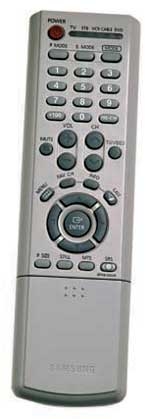Samsung HL-P5063W 50-inch DLP Rear-Projection HDTV Page 2
 PICTURE QUALITY Setup complete, I flipped the feel-good indie film The Station Agent into my progressive-scan DVD player. The picture looked punchy, with good contrast and a decent amount of shadow detail for a DLP TV. In a scene where the black-clad dwarf Finn settles into his new home in an abandoned train station, the gradations from dark gray to black in both his suit and the room's dark interior gave the image a satisfying sense of depth. Colors also looked natural. Skin tones were dead-on, and a wide array of green hues were visible in the trees and grass in outdoor shots. Bright colors, like the red lettering on an ice machine outside a grocery store, were also vivid.
PICTURE QUALITY Setup complete, I flipped the feel-good indie film The Station Agent into my progressive-scan DVD player. The picture looked punchy, with good contrast and a decent amount of shadow detail for a DLP TV. In a scene where the black-clad dwarf Finn settles into his new home in an abandoned train station, the gradations from dark gray to black in both his suit and the room's dark interior gave the image a satisfying sense of depth. Colors also looked natural. Skin tones were dead-on, and a wide array of green hues were visible in the trees and grass in outdoor shots. Bright colors, like the red lettering on an ice machine outside a grocery store, were also vivid.
Samsung's Digital Natural Image Engine (DNIE) video-processing mode improved the image clarity of bad-looking cable channels somewhat when I used the TV's standard (480i) connections. Picture resolution was poor, though, with artificial-looking edge enhancement. If you want the sharpest, cleanest image possible from standard-def video, use a progressive-scan DVD player. You should also consider upgrading to a model with a DVI (Digital Visual Interface) output that upconverts the DVD signal to high-def resolution. Image quality was stunning with V Inc.'s $250 DVI-enabled Bravo D2 DVD player.
|
Samsung has made serious strides with its DLP sets since I reviewed its first model nearly two years ago. The HL-P5063W is slimmer, lighter, less expensive, and has much better image quality. It isn't exactly cheap (although I've seen it advertised for as low as $3,000). You could probably score a similar-size tube-based set for around half its price, but you'd be missing out on DLP's remarkable picture detail, brightness, and wide viewing angle - not to mention this TV's svelte cabinet, which is about as slim as they come in a rear-projection set.
In the Lab
Color temperature (Standard/Warm 1 setting before/after calibration) Low window (20-IRE) .............. 7,475/6,680 K High window (100-IRE) ........... 7,795/6,585 K Brightness (Warm 1 color temperature, Standard picture setting before/after calibration, 100-IRE) ............ 46.6/44.9 ftL
With its Warm 1 color temperature selected, Samsung's HL-P5063W displayed good grayscale tracking after calibration, deviating only ±200 K from the 6,500-K standard through most of its range. (Calibration needs to be performed by a qualified technician with specialized equipment, so discuss it with your dealer before purchase, or call the Imaging Science Foundation at 561-997-9073.) There was a +800-K bump toward blue in the 30- to 40-IRE range, but its effect was negligible with DVD movies and TV.
Picture overscan was 3% on all sides with the DVI input, which is average, and 5% through the standard-definition inputs. I measured a -20% error on the green channel with the color-decoder-error pattern from the Avia test DVD. The effect was minor, but it skewed the color balance slightly toward red. Full-field gray DVD test patterns looked moderately noisy through the composite, component-, and S-video inputs, and picture resolution topped out at 480 lines - well below the 540-line limit of the DVD format. For best performance, you should feed the TV progressive-scan and high-definition signals whenever possible. Strangely, the set couldn't display 720p-format high-def signals from a Dish Network HDTV tuner using a component-video connection, but it had no problem with them via its DVI input.
- Log in or register to post comments




















































